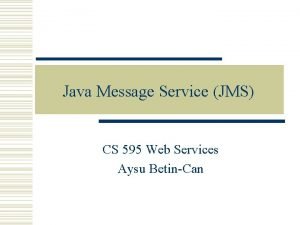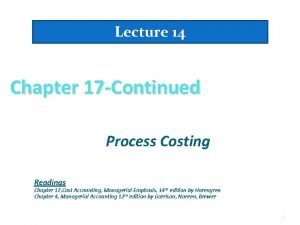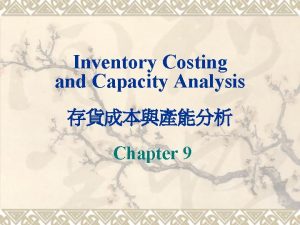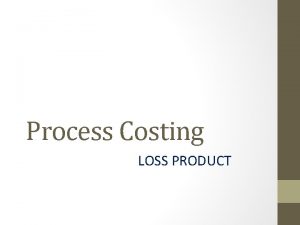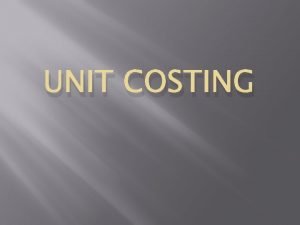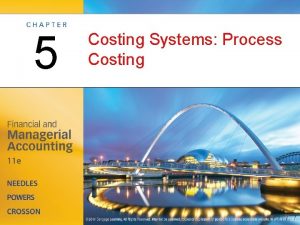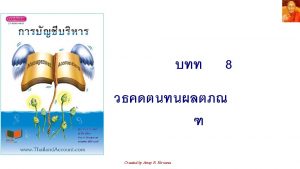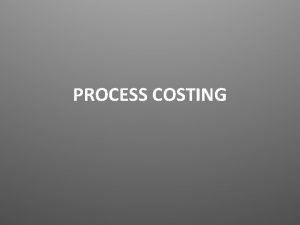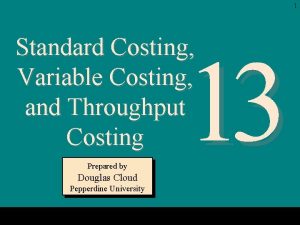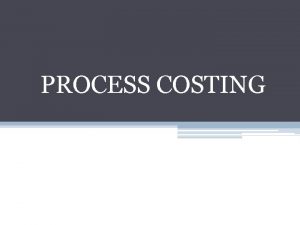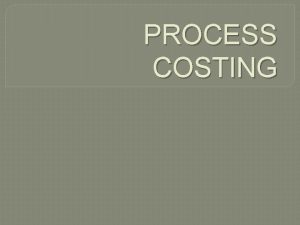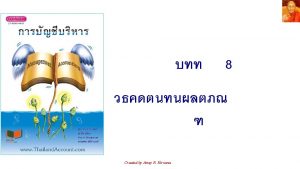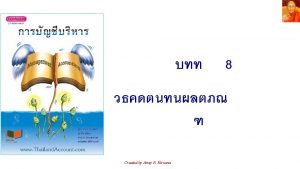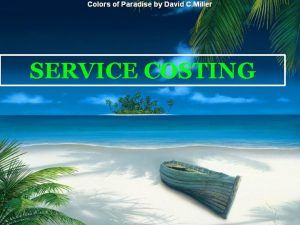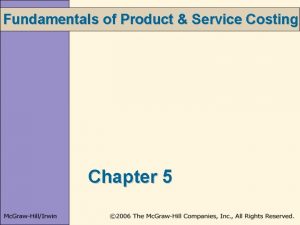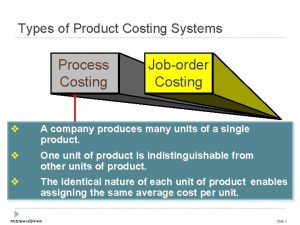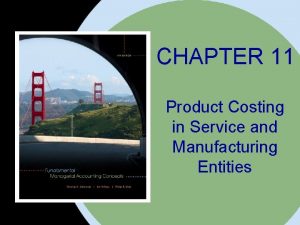Fundamentals of Product Service Costing Chapter 6 Mc





































- Slides: 37

Fundamentals of Product & Service Costing Chapter 6 Mc. Graw-Hill/Irwin

Learning Objectives: 1. Explain the fundamental themes underlying the design of cost systems. 2. Explain how cost allocation is used in a cost management system. 3. Explain how a basic product costing system works. 4. Understand how overhead cost is allocated to products. 5. Explain the operation of a two-stage allocation system for product costing. 6. Describe three basic types of product costing systems: job order, process, and operations. 6 -2

Cost System Keys to a good cost system Oriented to the needs of the decision makers Designed so that benefits exceed costs 6 -3

Cost Management System LO 1 Explain the fundamental themes underlying the design of cost systems. Provide information about costs relevant for decision making. The cost system accumulates and reports costs about processes, products, and services. 6 -4

Why Calculate the Cost of a Product? For Decision Making What should we sell? What sales price? What is the cost of goods sold? What is the cost of inventory? 6 -5

Designing a Cost System Focus Decision making How will managers use the information? Different information for different purposes l a i c an Fin the past l a i r age Man the future What type of decisions will be made? Cost-benefit Tes t Will benefits of improved decision making outweigh the costs of implementing the new cost system? 6 -6

• Cost systems should have a decision focus. It is important to design the cost system to facilitate the decision making of the users (or customers) of the cost data provided by the cost system. • Different cost information is used for different purposes. What works for one purpose will not necessarily work for another purpose. The cost information must provide the appropriate data for its intended purpose. • Cost information for managerial purposes must meet the cost -benefit test. Cost information can always be improved. But the benefits of improvements (i. e. , better decision making) must outweigh the costs of making the improvement. 6 -7

Cost Allocation and Product Costing LO 2 Explain how cost allocation is used in a cost management system. Cost Flow Diagram $ Direct materials DM $ Direct labor $ Overhead DL Traced Directly Product A OH Allocated using Direct labor $ Product B 6 -8

Why are cost flow diagrams useful in describing product costing system • They help describe how a cost management system works, just like a flow chart helps you understand how a process works. • Help managers identify and understand quickly the effect of changes in the system design on reported costs. 6 -9

How are product costing and cost allocation related • Cost allocation is the assignment of costs in cost pools to cost objects. • The cost objects may be products, services, customers, processes, or anything for which we want to know the cost. • Product costing uses cost allocation to calculate product costs. • Product costing is an application of cost allocation where products are the cost objects. 6 -10

The Inventory Accounts Raw Materials Beg. Inventory +Purchases = Raw Materials Available for Production - Raw Materials Transferred to WIP = Ending Inventory Work-In-Process Beg. Inventory + Direct Materials Transferred from Raw Materials + Direct Labor + Manufacturing Overhead = Total Manufacturing Costs - Cost of Goods Completed and Transferred to Finished Goods Beg. Inventory + Cost of Goods Completed and Transferred from WIP = Goods Available for Sale Cost of Goods Sold = Ending Inventory To the income statement = Ending Inventory 6 -11

A Product Costing System at Work LO 3 Explain how a basic product costing system works. How costs and units move through inventories. Beginning Balance Transfers In B T B I BB TI True for Transfers Out TO Ending Balance E B Raw Materials Work-In-Process Finished Goods Inventory account Beginning balance (BB) Less: Transfer out (TO) Plus: Transfer in (TI) Ending balance (EB) E B TO RM WIP FG 6 -12

The basic cost flow model appears as follows: Beginning balance + Transfers in – Transfers out = Ending balance • Beginning balance is the balance of inventory at the beginning of the period. • Transfers in represent inventory purchased or transferred in from another department (for example, raw materials would be goods transferred in to work in process) for the period. • Transfers out are goods transferred from one department to another (for example, work in process would be transferred out to finished goods). • Ending balance represents the amount of inventory in a department at the end of the accounting period. 6 -13

Product Costing System, Continued. . . How costs and units move through inventories. RM BB Purchases DM to WIP EB IM to OH WIP DM BB DL OH FG BB Transfers from WIP Transfers to FG EB Cost of goods sold EB To income statement 6 -14

Product Costing System, Continued. . . Baxter Paint April WIP Inventory Units – gallons of paint BB TI TO 0 100, 000 gallons E B 0 FG 6 -15

A Product Costing System at Work Baxter Paint Costs BB $0 April WIP Inventory TI DM $400, 000 DL $100, 000 OH $500, 000 TO $1, 000, 000 Cost per gallon $1, 000 E B $0 FG $10 per gallon 100, 000 6 -16

Work-In-Process Costs Let’s rewrite the basic cost flow model BB TI What are the costs? $0 DM $400, 000 DL $100, 000 OH $500, 000 $1, 000 TO E B Where are the costs at the end of the period? $1, 000 $0 FG 6 -17

Another Example: Costing with Ending WIP Inventory Given: Baxter Paint May WIP Units Gallons Beginning WIP -0 - Started in May Total 110, 000 Ending WIP (50% Complete) 20, 000 Transferred Out 90, 000 BB TI TO 0 110, 000 gallons 90, 000 gallons E B 20, 000 gallons These gallons are half finished. FG 6 -18

Equivalent Units Ending WIP Inventory How do we cost Baxter’s 20, 000 gallons of paint that are only half finished? 20, 000 gallons ½ finished Equivalent to 10, 000 gallons finished 20, 000 90, 000 10, 000 Total equivalent units 100, 000 . 5 To FG Ending WIP, 50% Complete 6 -19

Costing a Product, Continued. . . Baxter Paint May WIP Costs BB $0 TI TO DM $390, 000 DL $100, 000 OH $500, 000 $990, 000 ? E B ? FG Where is the $990, 000? What is the cost of the 90, 000 gallons transferred to FG and the 20, 000 gallons still in WIP? 6 -20

Costing a Product, Continued. . . Cost Flow Diagram Product Costing at Baxter Paints DM $390, 000 DL $100, 000 OH $500, 000 Total $990, 000 gallons 10, 000 gallons Equivalent Gallons (90%) (10%) 100, 000 FG WIP $891, 000 $99, 000 6 -21

Costing Multiple Products Grange Boats Units C 27 s C 20 s Total 10 30 40 Direct labor hours 2, 000 3, 000 5, 000 Machine Hours 1, 000 3, 000 4, 000 Direct Material $40, 000 $36, 000 $76, 000 Direct Labor $72, 000 $78, 000 $150, 000 Units produced Costs 6 -22

Costing Multiple Products Direct Materials Cost Pools Cost Objects $76, 000 Direct Labor $150, 000 Direct C 27 s C 20 s $40, 000 $36, 000 $72, 000 $78, 000 6 -23

Predetermined Overhead Rates LO 4 Understand how overhead cost is allocated to products. OH is indirect. Where do indirect costs belong? With C 27 s? Or with C 20 s? Indirect costs are allocated using a predetermined overhead rate. POHR is the cost per unit of the allocation base used to charge overhead to products. POHR $ Base 6 -24

Predetermined Overhead Rates, Continued. . . What are the estimated costs? POHR Estimated overhead $ Estimated allocation base What activity drives the overhead costs? Why use estimates? Products need to have costs applied during the period. The exact amount of indirect costs are not known until the end of the period. 6 -25

Grange Boats, Continued. . . Direct Labor hours C 27 s C 20 s Total 2, 000 3, 000 5, 000 Estimated Overhead Costs POHR $180, 000 5, 000 $180, 000 $36 / DLH 6 -26

Allocating OH to the Products OH Cost Pool $180, 000 Cost Allocation Rule Direct Labor Hours Cost Objects $36/DLH C 27 s C 20 s $72, 000 $108, 000 2, 000 DLH $36 3, 000 DLH $36 6 -27

Grange Boats, Continued. . . Units produced Direct Labor hours Machine hours Costs Direct Material Direct Labor OH Total Cost per unit C 27 s 10 C 20 s 30 Total 40 2, 000 1, 000 3, 000 5, 000 4, 000 $40, 000 72, 000 $36, 000 78, 000 108, 000 $76, 000 150, 000 180, 000 $184, 000 $222, 000 $406, 000 $18, 400 $7, 400 6 -28

Two-Stage Allocation Systems LO 5 Explain the operation of a two-stage allocation system for product costing. Cost Pool Overhead $180, 000 Intermediate Cost Pools Cost Allocation Rule Labor-related $108, 000 Direct Labor Costs Machine-related $72, 000 Machine Hours 6 -29

Two-Stage Allocation Systems, Continued. . . Labor-related Intermediate Cost Pools $108, 000 Direct Labor Cost $150, 000 Cost Allocation 72% DLC Machine-related $72, 000 Machine Hours 4, 000 $18/MH C 27 s C 20 s DLCost $51, 840 $56, 160 MH $18, 000 $54, 000 $69, 840 $110, 160 Cost Objects Allocated Overhead 6 -30

Grange Boats, Revisited. . . Costs C 27 s C 20 s Total $40, 000 $36, 000 $76, 000 Direct Labor 72, 000 78, 000 150, 000 OH @ 72% DLC 51, 840 56, 160 108, 000 OH @ $18/MH 18, 000 54, 000 72, 000 $181, 840 $224, 160 $406, 000 $18, 184 $7, 472 Direct Material Total Cost per unit 6 -31

Product Costing Systems LO 6 Describe three basic types of product costing systems: job order, process, and operations. Job Costing Operation Costing Process Costing An accounting system that traces costs to individual units or to specific jobs, contracts, or batches of goods. A hybrid costing system often used in manufacturing of goods that have some common characteristics plus some individual characteristics. An accounting system used when identical units are produced through a series of uniform production steps. Custom Homes Cornflakes Movies Automobiles Facial Tissues Services Computers Paint Clothing 6 -32

6 -31 Use direct labor hours to allocate overhead costs 6 -33

6 -38 Use 6 -31 data to compute individual cost per unit using machine hours to allocate overhead costs 6 -34

6 -43 6 -35

6 -36

6 -27 6 -37
 Differences between service costing and product costing
Differences between service costing and product costing Fundamentals of product and service costing
Fundamentals of product and service costing Process costing and hybrid product-costing systems
Process costing and hybrid product-costing systems Process costing and hybrid product-costing systems
Process costing and hybrid product-costing systems Hybrid costing system examples
Hybrid costing system examples Production cost report
Production cost report Job order costing and process costing
Job order costing and process costing Both job order costing and process costing
Both job order costing and process costing Absorption costing vs marginal costing
Absorption costing vs marginal costing Job costing vs process costing
Job costing vs process costing Job costing with process costing
Job costing with process costing Contract costing definition
Contract costing definition Variable costing vs absorption costing
Variable costing vs absorption costing Marginal costing format
Marginal costing format Abc costing vs traditional costing
Abc costing vs traditional costing Process costing vs job order costing
Process costing vs job order costing Advantages of activity based costing
Advantages of activity based costing Kaizen emfasis
Kaizen emfasis Activity based costing vs job costing
Activity based costing vs job costing Mixed cost
Mixed cost Perbedaan full costing dan variable costing
Perbedaan full costing dan variable costing Job costing vs batch costing
Job costing vs batch costing Target costing and activity based costing
Target costing and activity based costing Meaning of
Meaning of Cost sheet
Cost sheet Metode full costing dan variable costing
Metode full costing dan variable costing Job costing with process costing
Job costing with process costing Job order cost accounting
Job order cost accounting Product costing meaning
Product costing meaning The two basic types of product costing systems are
The two basic types of product costing systems are Product costing systems
Product costing systems Basically, product and service designing has
Basically, product and service designing has Fundamentals in food service operations
Fundamentals in food service operations Customer service and sales fundamentals
Customer service and sales fundamentals![[author] java message service - jms fundamentals course [author] java message service - jms fundamentals course](data:image/svg+xml,%3Csvg%20xmlns=%22http://www.w3.org/2000/svg%22%20viewBox=%220%200%20200%20200%22%3E%3C/svg%3E) [author] java message service - jms fundamentals course
[author] java message service - jms fundamentals course Jms(java)
Jms(java) Equivalent units fifo and weighted average
Equivalent units fifo and weighted average Chapter 9 inventory costing and capacity analysis
Chapter 9 inventory costing and capacity analysis
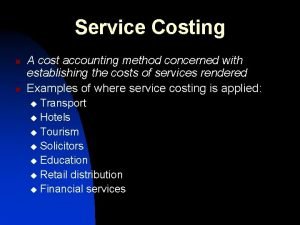
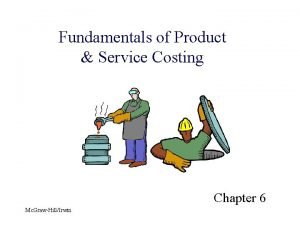
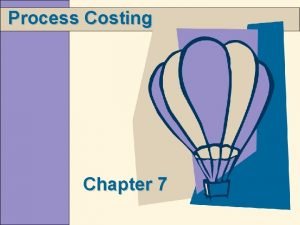
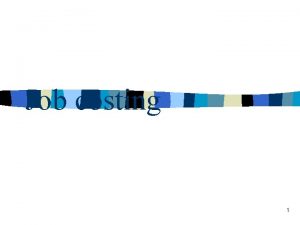
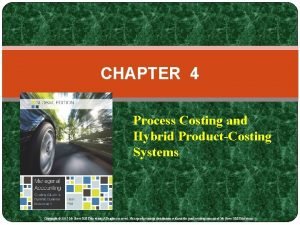
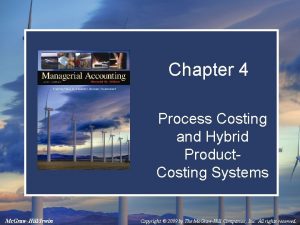
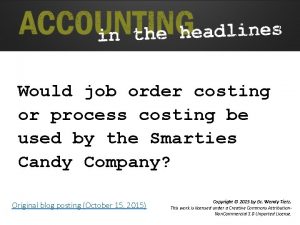

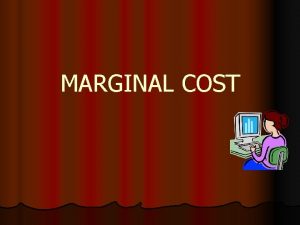

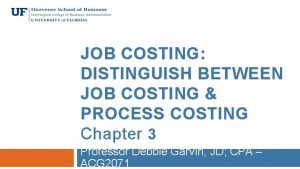


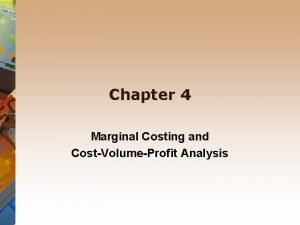
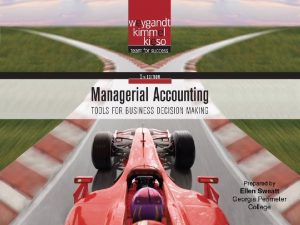

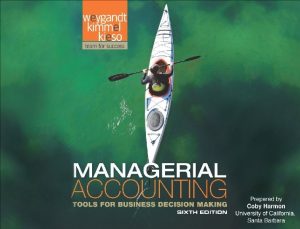
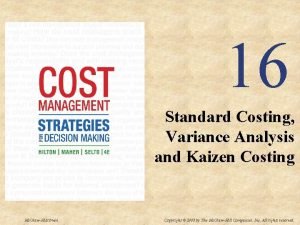
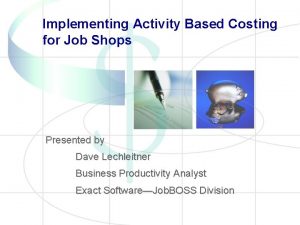
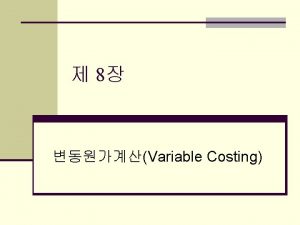
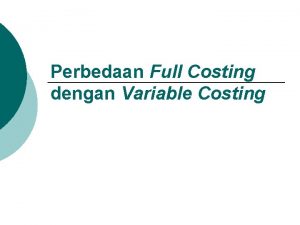
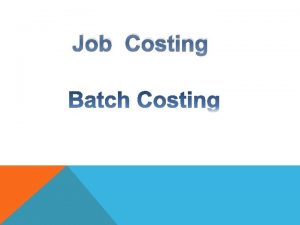
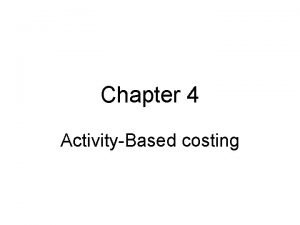

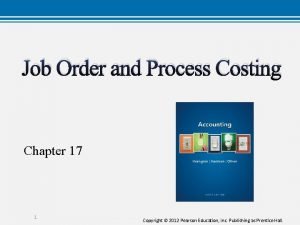

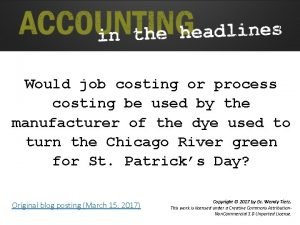
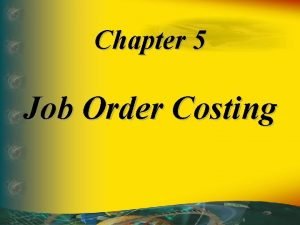


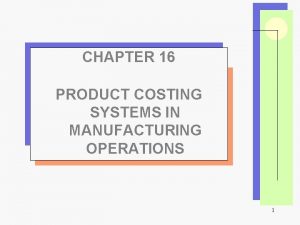
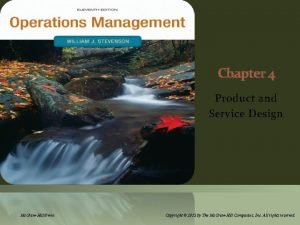
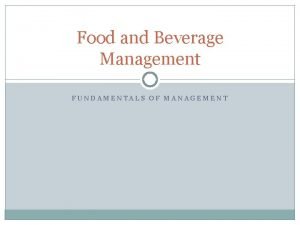
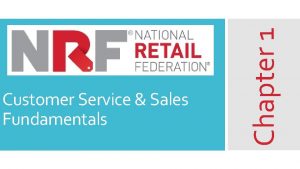
![[author] java message service - jms fundamentals course [author] java message service - jms fundamentals course](https://slidetodoc.com/wp-content/uploads/2020/09/381247_2ef7a792adac8a30d3544ffd2fa051e8-300x225.jpg)
